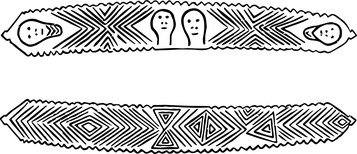| Coordinates WGS84 | 28°57'S, 146°37'E -28.95, 146.62 |
RHM1897P292F5
Title: Sketch of a message stick from Queensland reproduced by R.H.Mathews (1897, 1898), and by M.Frank (1940)
Description: Sketch of message stick on p. 292-293 of Mathews, R. H. 1897. "Message-sticks used by the Aborigines of Australia." American Anthropologist 10 (9):288-298, and subsequently reproduced in Mathews, R. H. 1898. "Message sticks." Scientific American Supplement 46:19195-1915. Sketch of message stick (fig. 32) on p. 345 in Maria Frank's "Botenstäbe in Australien"
Message: [...] with the verbal message he had received from Kubbi. The message was to the effect that Belay and Kunganooay requested Nanee and his two brothers, Bindi and Bunjalah, to come to Tinanburra for the purpose of joining them in a big corroboree, which was shortly to be held there. [...] "The two heads alongside of each other in the middle of the stick, figure 5, are the two brothers sending the message, and the single head at each end of the stick are the two brothers of Nanee, to whom the message was sent. There are 76 notches or nicks altogether, 42 of them being on one edge; on the other edge there are 18 notches, and then a smooth space of about an inch and a quarter, after which there are 16 more notches. These notches are added merely for ornamentation. The remaining marks on the flat surface, and also all the marks on the other side of the stick, figure 6, consisting of V-shaped lines, triangles, and quadrilaterals of the yammiunyamun pattern are for ornamental purposes only." (1897, p.295) "This message was to the effect that Belay and Kunganooey requested Nanee and his two brothers, Bindi and Bunjalah, to come to Tinanburra for the purpose of joining them in a big corroboree which was shortly to be held there. [...] The two heads alongside each other in the middle of the stick (1) are the two brothers sending the message, and the single head at each end are the two brothers of Nanee, to whom the message was sent. [...] The notches are added merely for ornamentation. The remaining marks on the flat surface, and also all the marks on the other side of the stick (2), consisting of V-shaped lines, triangles, and quadrilaterals of the yammunyamun pattern, are for ornamental purposes only." (1898) Frank 1940, p.343: "Menschliche Kopfe sind auch noch auf einem vonMathews (61, S. 142) dargestellten Stab zu finden (Fig. 32). Es ist dies ein Fall, in dem das pars pro toto genommen wird. Die zwei Köpfe an den Seiten bedeuten die Sender und die zwei anderen in der Mitte die eingeladenen Freunde." Translation JB: "Human heads are also to be found on a staff represented by Mathews (61, p. 142) (Fig. 32). This is a case where the pars pro toto is taken. The two heads on the sides signify the sender and the two other in the middle the invited friends."
Creator of Object: Sender: "Belay and Kunganooay, two brothers, of the Kubbi class and Iguana totem, both of whom are chief men of the Tinanburra tribe" (1897, p.294) Recipient: "Nanee, Kumbo Kangaroo, one of the head-men of the Culgoa tribe, residing at Goodooga" 1897, (p.294)
Date Created: 1897
Notes on date created: terminus ante quem
Item type: image of a message stick (artefact missing)
Subtype: traditional
Linguistic area 1: Chirila: Muruwari Austlang: D32 - MURUWARI / MURRAWARRI Glottolog: muru1266
Linguistic area 2: Chirila: Yuwaalaraay Austlang: D27 - Yuwaalaraay Glottolog: yuwa1242
Notes on linguistic areas: The message stick is associated with the “Tinanburra tribe on the Cuttaburra river in Queensland, sent to "Culgoa tribe, residing at Goodooga" on the Bokhara river, in New South Wales (1897, p.294-295); Tinanburra, on the Cuttaburra River in Queensland, sent to Goodooga on the Bokhara River in New South Wales (1898) The 'Tinanburra tribe' is possibly a division of Muruwari since Tinnenburra station was on the border between Muruwari, Badjiri, Gunu and Baridji. Goodooga is within the Muruwari area."Culgoa tribe" presumably refers to the people living on the Culgoa river, namely the Muruwari. See: https://collection.aiatsis.gov.au/austlang/language/d32
Cultural region: QLD/NSW
Semantic domains: sd_ceremony, sd_person, sd_person_recipient, sd_person_sender, sd_request_invitation_ceremony, sd_skin
Sources:
Collector: I obtained the message-sticks and all the details respecting them from Mr James E. Miller, a police trooper stationed at Goodooga township. He has been traveling through that district in the discharge of his official duties for some years past and is well acquainted with the numerous aboriginal population, who still preserve their ancient customs. (1897, p.292) R. H. Mathews "From a number of message sticks in my possession I have selected three [...]" (1898)
Coordinates: 28°56'52.332000"S,146°37'9.804000"E (-28.94787, 146.61939)
Notes on coordinates: Chirila centroid coordinates for Muruwari
URL institution: http://nla.gov.au/nla.obj-52785381
Notes: PK: It is puzzling that the two heads in the centre of the artefact are not bearded while those at the extremes are bearded. Perhaps a distinction in age or initiation status is intended.
Media Files:
Data Entry: Olena Tykhostup






